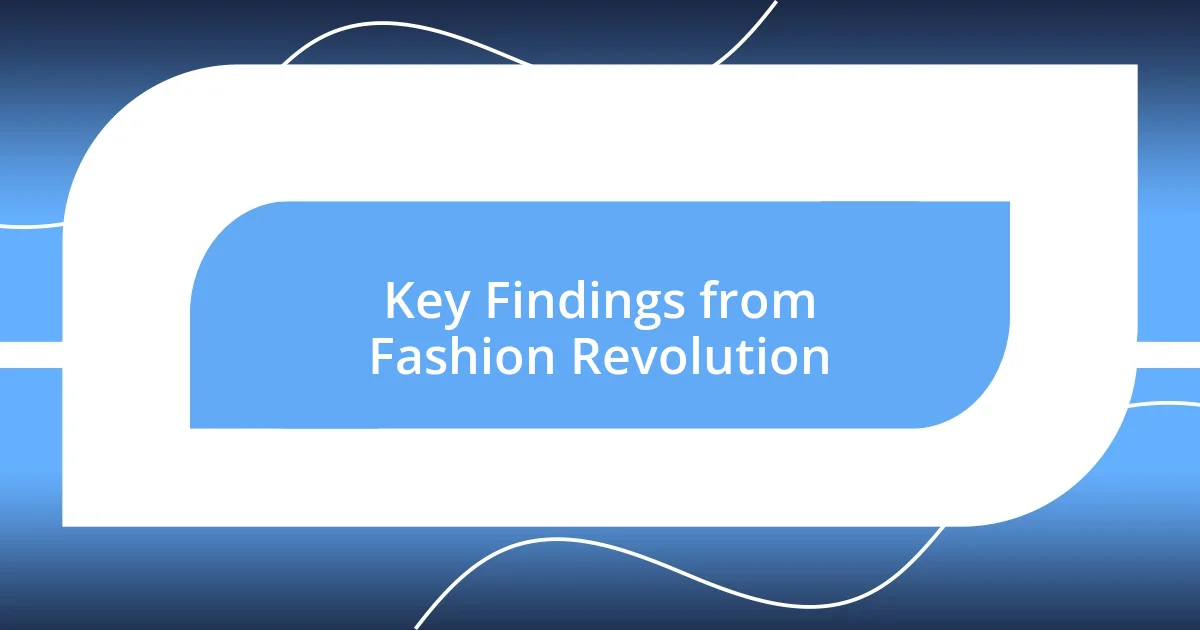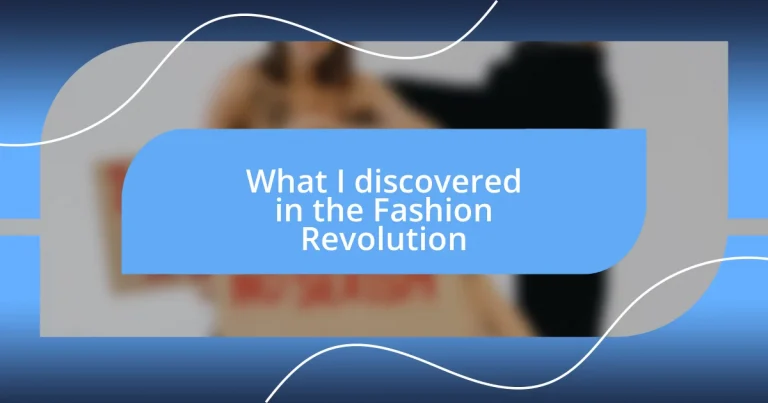Key takeaways:
- The Fashion Revolution emphasizes the importance of transparency and sustainability, encouraging consumers to make informed choices that can drive ethical practices in the fashion industry.
- The negative impacts of fast fashion include environmental damage, worker exploitation, and economic waste, highlighting the need for mindful consumption and supporting sustainable alternatives.
- Personal actions like caring for existing clothing, engaging in secondhand shopping, and educating others about ethical fashion are vital steps individuals can take to contribute to the movement for change.

Understanding Fashion Revolution
The Fashion Revolution is more than just a movement; it’s a global call for transparency and sustainability in an industry often shrouded in secrecy. I remember the first time I stumbled upon a documentary about fast fashion. It struck me deeply, and I couldn’t help but ask myself: how many garments have I owned that contributed to pollution and exploitation? This realization pushed me to rethink my own wardrobe choices.
As I delved deeper, I discovered that this revolution is rooted in the very fabric of our society. It advocates for ethical practices that not only empower workers but also respect our planet. I recall attending a local event where creators shared their journeys toward conscious fashion—hearing their stories made me feel connected to a larger purpose. Isn’t it compelling to think that every purchase can be a vote for a better world?
Embracing the Fashion Revolution requires us to challenge the status quo. When I started sharing my own insights on social media, I was amazed by how many others felt the same way. If we all re-evaluated our choices, wouldn’t we set the stage for a profound change in how fashion is perceived? The answer seems clear: the revolution thrives on our collective voice.

Key Findings from Fashion Revolution
As I explored the landscape of the Fashion Revolution, I was struck by the overwhelming need for transparency. One of the key findings is that consumers increasingly demand to know the origins of their clothes. I remember a moment when a friend showed me the label inside her new dress; it was like peeling back the layers of a mystery. This craving for information is changing how brands operate, pushing them to be more accountable.
- Consumers are prioritizing sustainable and ethical fashion, often favoring brands that share their production processes.
- There’s a growing interest in second-hand and vintage clothing, reflecting a shift in mindset away from the ‘new at any cost’ mentality.
- Educational campaigns are playing a significant role in raising awareness about the environmental impacts of fast fashion.
- Collaboration between brands and activists is fostering innovation in sustainable practices, highlighting the importance of community in driving change.
Each discovery opened my eyes wider. It’s empowering to witness how narratives around clothing are transforming. Just a few years ago, I would have never considered thrifting a viable option. Now, it feels like a badge of honor, contributing to a more circular economy. This personal transformation signals a broader societal shift, hinting at positive changes ahead in the fashion world.

Impact of Fast Fashion Practices
The consequences of fast fashion practices extend beyond aesthetics; they ripple through our environment and communities. After I saw firsthand how fast fashion contributes to water pollution, I became more mindful of my clothing choices. I remember walking past a river in an industrial area, colored unnaturally from effluents, and it hit me—this was the ugly side of fashion. It made me question: what do our clothes cost the planet? Every garment that’s tossed aside contributes to this ongoing crisis, and I realized that our purchasing habits play a significant role in this cycle.
Moreover, the exploitation of workers caught in the fast fashion web is deeply alarming. I recall a discussions with a friend who worked in a garment factory. She shared stories of long hours and meager pay, serving as a sobering reminder of the human cost behind our trendy outfits. Knowing that my choices could either support or harm vulnerable communities has been a wake-up call. It’s essential to consider that behind every piece of clothing, there are lives affected by our desire for cheap, trendy fashion.
Finally, the economic implications are profound as well. With fast fashion, we often see a short-lived cycle where quality is sacrificed for quantity. I remember purchasing a top that fell apart after just a couple of washes—it was a disappointing reminder of how cheap clothing can lead to long-term wastefulness. Transitioning to sustainable brands or thrift shopping not only promotes quality but also supports a shift toward responsible consumption. Perhaps if we all committed to rethinking our habits, we could dismantle this cycle of waste, promoting a healthier economy both for ourselves and our planet.
| Impact of Fast Fashion | Consequences |
|---|---|
| Environmental Damage | Pollution and resource depletion from overproduction |
| Worker Exploitation | Low wages and poor working conditions |
| Economic Waste | Short-lived clothing contributing to landfills |

Sustainable Fashion Alternatives
The allure of sustainable fashion alternatives has truly grown on me. I remember stepping into my local thrift shop, the atmosphere buzzing with potential. Every rack was filled with unique pieces, each telling its own story. The thrill of discovering a vintage jacket made me realize that choosing second-hand doesn’t just reduce waste; it sparks genuine joy and creativity in personal style.
I’ve also found that upcycling is an exciting avenue. A friend of mine transformed an old, oversized shirt into a chic going-out top, and I was amazed by her ingenuity. This hands-on approach not only prevents clothing from ending up in landfills, but it also fosters a sense of pride. Have you ever considered how much more meaningful it is to wear something you’ve repurposed yourself? It adds an emotional layer to your wardrobe, turning everyday outfits into expressions of who you really are.
Furthermore, I’ve become increasingly drawn to ethical brands that prioritize transparency and sustainability. My latest purchase from a company that sources organic cotton and pays fair wages felt like more than just a transaction; it was a conscious decision to support practices that align with my values. As I slipped on that garment, the soft fabric felt different—it carried the weight of positive impact. Doesn’t it feel good to know your clothes reflect your commitment to a better world? Exploring these alternatives has transformed my relationship with fashion into something more purposeful and fulfilling.

Ethical Production in Fashion
Ethical production in fashion has opened my eyes to a world where transparency and responsibility reign. I remember attending a local fair dedicated to sustainable brands, where I chatted with a designer who ethically sourced her materials. Listening to her passion about ensuring fair labor practices truly inspired me; it made me realize that my purchasing power can lead to meaningful changes. Isn’t it amazing how the choices we make in fashion can support a community rather than exploit it?
As I explored ethical fashion, I discovered a wealth of brands dedicated not just to eco-friendly materials, but also to empowering artisans. I once bought a handwoven bag from a collective of women in a developing country, which sparked a delightful connection. Each time I carry it, I feel like I’m transversing a bridge between cultures. This experience made me reflect on how our fashion choices can tell stories that transcend borders. Don’t you think it’s powerful to wear something that stands for empowerment instead of exploitation?
Another fascinating aspect of ethical production is the emphasis on slower manufacturing processes. I recall trying on a dress from a brand that took six months to create, using only natural dyes and local labor. The intricate details made me appreciate the artistry behind the garment, which felt like a stark contrast to the mass-produced items I was used to. Each time I wear it, I’m reminded that fashion doesn’t have to be disposable; it can embody a rich narrative. How rewarding it is to invest in a piece that supports artisans and promotes conscious consumption instead of contributing to a cycle of waste!

How to Support Fashion Revolution
Supporting the Fashion Revolution starts with being a conscious consumer. I remember a time when I mindlessly bought clothes, often just because they were trendy. Now, I make a point to research brands before making a purchase. This simple act of due diligence allows me to align my spending with my values, ensuring that I support brands prioritizing ethical production and sustainable practices. It’s empowering to know that my choices can drive change in the industry, don’t you think?
Participating in local clothing swaps has also become a favorite of mine. The last one I attended was filled with laughter and camaraderie as we all searched for hidden gems in each other’s unwanted items. Not only did I leave with a fabulous dress, but I also felt connected to my community in a unique way. Swapping clothes reduces waste while fostering relationships—what could be better than that?
Lastly, advocating for change is another powerful way to support the Fashion Revolution. I recall joining a social media campaign aimed at raising awareness about the environmental impact of fast fashion. Sharing my insights and learning from others made me realize that it’s not just about individual behavior; it’s about creating a collective voice. I often wonder, how can we motivate others to join in this journey with us? Whenever I share a post or engage in discussions, I feel like I’m contributing to a movement bigger than myself, and that’s incredibly fulfilling.

Personal Action Steps for Change
Taking personal action towards change in the fashion industry can start with a simple yet profound step: caring for what we already own. I vividly recall the moment I decided to repair a pair of jeans that I thought were beyond salvation. After watching a few online tutorials, I was surprised at the joy I felt in giving them new life. It made me wonder, how many cherished pieces are we ready to toss away rather than mend? This experience shifted my perspective; it became clear that prolonging the life of clothing not only saves money but also reduces waste—an essential factor in sustainable fashion.
Embracing secondhand shopping has transformed my approach to fashion as well. I remember walking into a thrift store, feeling a rush of excitement as I sifted through racks filled with unique styles and forgotten treasures. Each item has its own story, and finding them felt like uncovering pieces of history. Are we not drawn to the notion that our fashion choices can reflect the narratives of those before us? This practice not only supports sustainability but also allows for creativity in building a wardrobe filled with one-of-a-kind finds.
Lastly, I’ve found that educating myself and others about ethical fashion practices deepens my commitment. I often host casual gatherings with friends where we discuss sustainable brands and the impact of our purchasing habits. During one of these sessions, a friend shared her journey toward creating an eco-friendly fashion blog. It reminded me that our conversations can spark action, and I now genuinely believe that sharing knowledge is pivotal. How can we expect change if we don’t have these discussions? By expanding our understanding collectively, we’re not just making informed individual choices; we’re nurturing a community geared towards a more ethical fashion future.














